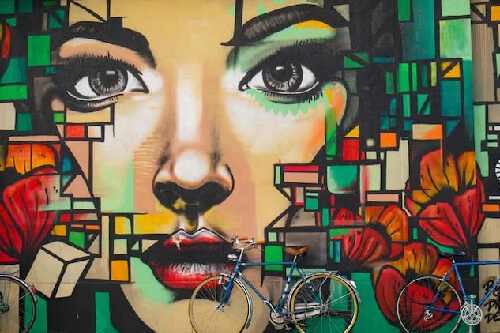
Message from Ms. Audrey Azoulay, Director-General of UNESCO, on the Occasion of World Art Day文章源自英文巴士-https://www.en84.com/11152.html
教科文组织总干事奥德蕾·阿祖莱世界艺术日致辞文章源自英文巴士-https://www.en84.com/11152.html
文章源自英文巴士-https://www.en84.com/11152.html
15 April 2021文章源自英文巴士-https://www.en84.com/11152.html
2021年4月15日文章源自英文巴士-https://www.en84.com/11152.html
文章源自英文巴士-https://www.en84.com/11152.html
Bringing people together, inspiring, soothing and sharing: these are the powers of art, the importance of which has been made emphatically obvious during the coronavirus disease (COVID-19) pandemic. With hundreds of thousands of people directly affected by the virus and billions more either in lockdown or battling the pandemic on the front lines, this World Art Day is a timely reminder that art has the power to unite and connect in times of crisis.文章源自英文巴士-https://www.en84.com/11152.html
文章源自英文巴士-https://www.en84.com/11152.html
艺术所具有的各种力量:让人们走近彼此、启迪心灵、感受宁静、体验共享,在当下冠状病毒病大流行时期,显示出格外重要的意义。目前有成千上万的人直接感染了病毒,有数十亿人在居家隔离或者战斗在疫情第一线,今年的世界艺术日恰逢其时地提醒我们,艺术有能力在危机时期让人们团结一心,彼此相连。文章源自英文巴士-https://www.en84.com/11152.html
文章源自英文巴士-https://www.en84.com/11152.html
Since March 2020, we have seen a multitude of artists and institutions lead resilience-building cultural initiatives. The time of COVID-19 is thus, undeniably, also a time of opening up towards others and to culture, which reinforces the relationship between artistic creation and society. In order to weather the crisis and inspire the future, we need not only educational continuity, but also cultural continuity: neither learning nor culture must stop.
自2020年3月以来,我们看到艺术家和文化艺术机构百花齐放,通过文化提供韧性的源泉。不可否认的是,疫情肆虐的这段时期,也代表着向他者开放、向文化开放从而加强艺术创作与社会联系的一段时期。为度过危机,启示未来,正如教育必须有连续性一样,文化也必须有连续性。
Our Organization would thus like to pay tribute to the solidarity shown by artists and institutions at a time when art is suffering the full force of the effects of a global health, economic and social crisis.
正因如此,教科文组织谨向艺术家和文化艺术机构致敬,致敬它们在艺术遭遇全球卫生危机和经济社会危机冲击的时刻所表现出的这种团结精神。
Indeed, the extended closure of museums, theatres and concert halls and the cancellation of concerts and festivals have plunged many institutions into uncertainty. In a sector where employment is often informal and unstable, and in the absence of an appropriate social safety net, artists and culture professionals too often find themselves helpless in the face of the loss of income brought on by these circumstances.
事实上,博物馆、剧院、演出场馆的长期关闭,以及音乐会或文化节日的取消,都让许多机构陷入不确定的状态。此外,该行业非正式就业和不稳定工作居多,也缺乏适当的社会保障,置身其中的艺术家和文化专业工作者往往因失去这些收入来源而陷入贫困。
This shows us just how much we need to accord artists appropriate status, as urged by UNESCO’s 1980 Recommendation concerning the Status of the Artist, in order to bolster respect for their rights and boost the resilience of arts and culture.
因此,我们认识到迫切需要捍卫艺术家的应有地位,正如教科文组织1980年建议书所呼吁的那样,以提高对艺术家权利的尊重并加强艺术和文化的韧性。
Furthermore, for the public, this period is increasing inequalities with respect to access to culture and the diversity of cultural expressions. The measures being taken severely limit the public’s ability to enjoy cultural goods and services in their diversity. These inequalities are all the more acute for vulnerable groups, which are ordinarily affected by the digital divide – such is the case of millions of women and indigenous peoples – and are having even greater difficulty in gaining access to culture.
另一方面,对于公众而言,这一时期导致了与获取文化以及文化表现形式多样性有关的不平等现象加剧。实际上,所采取的各方面措施严重限制了公众利用文化产品和服务多样性的能力。对于通常就受到数字鸿沟影响的弱势群体(例如数百万妇女或土著人民)而言,这些不平等现象会更加严重,因为他们在获取文化方面面临更多困难。
The challenge of keeping art alive, now and in the future, is therefore twofold: to support culture professionals and cultural institutions, and to promote access to art for all.
因此,为了艺术在现在和未来得以生生不息,挑战是双重的:既要支持文化专业人员和文化机构,又要为所有人获取艺术创造条件。
In a challenge of justice and equality, and in order to better identify priority needs, it is necessary to listen to all the voices of the artistic world in their globality and diversity. It was thus with the aim of affirming the resilience of art in this period and preparing for the future that UNESCO launched, exactly one year ago, the “ResiliArt” movement. To date, more than 1,200 artists and professionals have participated in hundreds of debates throughout the world, making it possible to formulate 100 recommendations to inspire political action.
在正义和平等的挑战中,为了更好地确定优先需要,有必要全面且多方面听取艺术界的所有声音。因此,为了彰显艺术在面对这一时期的韧性所在,同时也为了着眼于未来,教科文组织在整整一年前发起了“坚韧艺术”运动。到目前为止,已有1200多名艺术家和专业人士参加了世界各地的数百场讨论,并制定了100项建议,以指导政治行动。
These challenges can only be met through far-reaching cultural policies aimed at helping creative communities overcome this crisis and protecting and improving the status of artists. It was in this very spirit that in October 2020 UNESCO published Culture in Crisis, a policy guide which details the concrete support measures which States have taken to assist the cultural and creative industries.
只有通过旨在帮助创意社区克服这一危机、保护和改善艺术家境况的大规模文化政策,才能应对这些挑战。正是本着这种精神,教科文组织于2020年10月发布了《危机中的文化》政策指南,统计了世界各国支持文化和创意产业的具体扶持措施。
“Just as man needs oxygen to survive, he needs art and poetry.” This crisis reminds us, as emphasized by Aimé Césaire, how much art and culture are vital needs for humanity, how much they are the ferment of our unity and resilience. By taking part in this movement of great cultural momentum, let us all prove that in this period of social distancing, art brings us closer together than ever before.
“人类生存需要氧气,也需要艺术和诗歌”。诚如艾梅·塞泽尔所言,这场危机也提醒我们,艺术和文化是人类的基本需要,其中也凝聚着我们的团结和韧性。通过广泛参与这场促进文化的行动,让我们所有人都表明,在这个需要保持社交距离的特殊时期,艺术比以往任何时候都让我们更紧密地走到一起。

